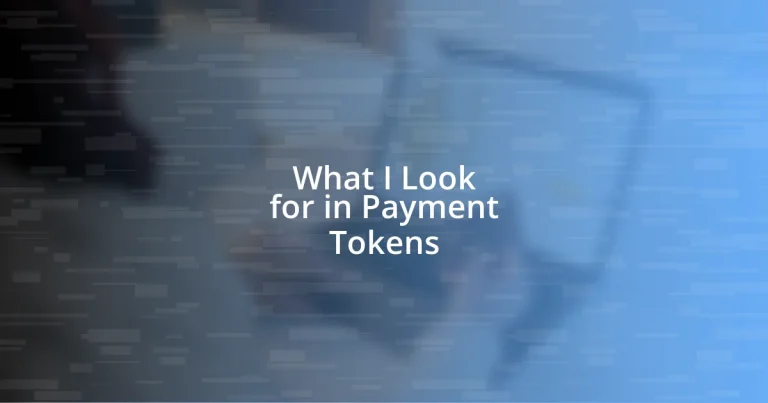Key takeaways:
- Payment tokens enhance transaction security by using encryption and tokenization, replacing sensitive information with unique identifiers.
- Transaction speed is crucial for customer satisfaction; technologies like blockchain enable faster payments compared to traditional methods.
- User adoption rates reflect the effectiveness and ease of use of payment tokens, with regulatory compliance significantly affecting user confidence and trust.

Understanding Payment Tokens
Payment tokens are essentially digital representations of value that facilitate transactions without directly sharing sensitive information, such as credit card numbers. When I first encountered payment tokens, I was struck by the elegance of their design—transmitting data in a way that enhances security and trust in an increasingly digital world. Isn’t it reassuring to know that our financial information can remain securely tucked away while we still enjoy the convenience of online transactions?
From my perspective, the real magic lies in how these tokens work. They replace vulnerable data with a unique string of numbers and letters, often generated through encryption. I remember my excitement when I first utilized a payment token; it felt like stepping into a new age of payments where I could shop online with peace of mind, knowing my information was safe.
I often think about how payment tokens are changing the landscape of our financial interactions. Have you ever paused to consider how much easier life is because of these innovations? For instance, every time I make a quick online purchase using a payment token, I’m reminded of the efficiency and security that technology brings, fundamentally transforming the way we engage in commerce today.

Importance of Security Features
The importance of security features in payment tokens cannot be overstated. I remember the first time I heard about data breaches affecting online shoppers; it sent shivers down my spine. Knowing that payment tokens are designed with robust security measures gives me a significant sense of relief. These features not only protect sensitive information but also build trust between consumers and merchants.
Here are a few key security features to look for in payment tokens:
- Encryption: Ensures that sensitive data is scrambled and unreadable to unauthorized users.
- Tokenization: Replaces sensitive information with unique identifiers, making it useless if intercepted.
- Fraud Monitoring: Continuously tracks transactions for suspicious activities, alerting users and businesses.
- Multi-Factor Authentication: Requires multiple forms of verification before completing transactions, adding an extra layer of security.
Whenever I engage in online payments, I consciously remind myself of these features. It’s a comforting thought that I’m not just another target in a sea of internet transactions.

Evaluating Transaction Speed
When I evaluate transaction speed for payment tokens, consistency is key. I vividly recall a time when I eagerly awaited a purchase confirmation, only to be frustrated by slow processing times. It’s often in these moments that I realize just how crucial transaction speed is for a seamless shopping experience. A fast, reliable transaction not only enhances customer satisfaction but also encourages repeat business.
Moreover, I’ve noticed that the technology behind payment tokens directly impacts how swiftly transactions are completed. For instance, some systems utilize blockchain technology, which allows for near-instantaneous processing. I remember when I made a purchase with a cryptocurrency-based payment token; the speed of the transaction left me impressed, almost as if the money vanished and reappeared in an instant. Can you relate to that exhilarating feeling of immediacy when your transaction goes through without a hitch?
To clearly visualize the transactions I often engage with, here’s a comparison of different payment methods regarding transaction speed:
| Payment Method | Average Transaction Speed |
|---|---|
| Traditional Credit/Debit Cards | 1-5 minutes |
| Payment Tokens (Crypto-based) | Seconds to minutes |
| Bank Transfers | 1-3 business days |

Assessing Network Scalability
When assessing network scalability for payment tokens, I always consider how well a system can handle increasing transaction volumes. There was a particular occasion when I participated in a flash sale that overwhelmed the payment system, leading to transaction failures. It’s disheartening when you’re ready to make a purchase, only to find that the network isn’t up for the challenge.
I find it intriguing how different platforms approach scalability. For example, some utilize layer-two solutions, allowing them to process thousands of transactions per second without compromising security or speed. From my perspective, a scalable network not only caters to high demand but also adapts dynamically to fluctuating loads, ensuring seamless transactions even during peak times.
One important question I often ask myself is whether a payment token’s underlying technology can scale without inconveniencing users. I remember analyzing a payment token that faltered under high traffic, leaving me frustrated and questioning its viability. Ultimately, seeing a network capable of scaling efficiently fosters trust and boosts my willingness to transact. After all, who wants to worry about a system collapsing when it matters most?

Analyzing User Adoption Rates
Analyzing user adoption rates for payment tokens can be incredibly telling about their overall effectiveness. I remember when I first explored a popular payment token, watching its user base grow exponentially over a few months. The excitement in the community was palpable; it felt like we were all part of something revolutionary. This surge in adoption often indicates a product that resonates with users, aligning not just with their needs but also their preferences.
What fascinates me is how user adoption directly correlates with ease of use. I recall a time when I tried a new payment token that promised seamless integration with my favorite online stores. Initially skeptical, I was pleasantly surprised at how straightforward the signup process was. In my view, if a token isn’t intuitive, user reluctance can stall adoption rates. I often ask myself, how many potential users simply give up due to complicated procedures, missing out on the benefits of an otherwise effective payment solution?
User feedback also plays a huge role in adoption stories. Some tokens thrive on social media endorsements while others stumble due to negative reviews. I once chose not to adopt a certain token after reading multiple accounts of poor customer service experiences. This reinforces my belief that transparent, user-friendly support often converts tentative interest into solid user bases. What’s your experience with feedback shaping your choices in the digital payment realm?

Examining Regulatory Compliance
Examining regulatory compliance is a critical step in my evaluation of payment tokens. I still vividly recall a time when I enthusiastically explored a new token, only to discover later that it lacked the necessary regulatory approval in my jurisdiction. It was a frustrating realization, as I had invested time and interest into something that could ultimately be risky or unsustainable.
Regulatory frameworks vary widely across industries and regions, which makes staying informed essential. When diving deep into a payment token, I always research its adherence to regulations like Anti-Money Laundering (AML) and Know Your Customer (KYC) requirements. I once came across a token that boasted compliance but, upon closer inspection, had significant gaps that raised red flags for me. This experience taught me that a certification or claim isn’t enough—thorough scrutiny of a token’s compliance practices is key to ensuring its legitimacy.
I often ponder how regulatory compliance impacts user confidence. For instance, I remember hesitating to adopt a promising payment token because of concerns over its regulatory standing. It made me wonder, do we sometimes overlook critical compliance aspects in our eagerness to embrace innovation? Ultimately, I’ve learned that a transparent approach to regulation not only safeguards my investments but also cultivates trust within the entire ecosystem.

Identifying Use Case Viability
Identifying use case viability is pivotal when assessing payment tokens. I recall a moment when I diligently researched a token that promised to streamline microtransactions, a feature I believed would be revolutionary. However, as I analyzed its real-world applications, I quickly realized that its actual usage scenarios were too niche, limiting its reach and potential appeal.
What strikes me most about use case viability is the diversity of applications. In one instance, I encountered a token designed for the gaming industry. Initially, I was skeptical, wondering if its utility would extend beyond that specific sector. Yet, the token successfully partnered with several popular game developers, demonstrating its adaptability and broad acceptance. This made me reflect: how often do we underestimate a token’s potential by confining it to a single use case?
Practicality plays a crucial role in evaluating a token’s viability. I remember exploring a token designed for international remittances, considering how cumbersome traditional methods can be. It struck me that if a payment token could genuinely simplify those processes and save users both time and money, it would likely thrive. The key question for me remains: does the token address a genuine problem that users face, or is it merely adding complexity to an already crowded space?












